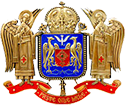

Message of His Beatitude DANIEL, Patriarch of Romania, at the anniversary of 1150 years since the Christianisation of the Bulgarian people, 3 May 2015
His Beatitude NEOPHYTE,
Patriarch of the Bulgarian Orthodox Church
Your Beatitude,
Beloved brother in Christ the Lord,
CHRIST IS RISEN!
![]() This year, 2015, together with the whole Bulgarian Orthodox Church we share in the joy of celebrating 1150 years since the Christianization of the Bulgarian people.
This year, 2015, together with the whole Bulgarian Orthodox Church we share in the joy of celebrating 1150 years since the Christianization of the Bulgarian people.
This bright festive moment aims to solemnly highlight the continuity and fruitfulness, over the centuries, of the confession of Christ on the soil of Bulgaria. This is also an appropriate opportunity to highlight the traditional Orthodox communion in the context of the South Eastern European area of the Balkan Peninsula, a space where the ages-old and permanence of fraternal relations between the Romanian Orthodox Church and the Bulgarian Orthodox Church are manifested.
After the Bulgarian people received the faith in Christ during Tsar Boris, in the year 864, at the end of the first millennium an extensive process of Christianization of the Slavic peoples of Eastern, Central and South Eastern Europe has followed. The relations of Slavic people with Christians in the area of the ethno-genesis and Christianization of the ancestors of the Romanian people contributed to this process from the early centuries of the Christian era, beginning with the preaching of Saint Andrew the Apostle in Scythia Minor (today Dobrogea). A special cooperation between Romanians and Bulgarians has taken place during the Romanian-Bulgarian Tsardom (12th – 14th centuries). It remains a fundamental milestone in this respect the particularly interesting correspondence, rich in content between Metropolitan Anthimos Critopoulos of Walachia and Saint Pious Nicodemus of Tismana with Saint Euthymius, Patriarch of Tarnovo, in the second half of the 14th century.
After the occupation of the Balkan Peninsula up to the Danube by the Ottoman Empire at the end of that century, followed by the fall in the same domination of Constantinople itself, in the year 1453, the Romanian Principalities have continued to provide substantial brotherly support to the Bulgarian Church and the entire Eastern Orthodoxy, in general, especially through religious books printed in Slavonic in the 16th – 17th centuries, in Romanian printing houses North of Danube.
There is well known, on the other hand, the material aid, especially churches built by many prominent ruler princes of the Romanian Principalities, in the South of the Danube, both on the territory of today's Bulgaria and in the Mount Athos, where, among the monastic precincts, Zograf monastery, with mainly ethnic Bulgarian living there, was especially helped. In this regard, the Holy Ruler Princes Stephen the Great († 1504) and Neagoe Basarab († 1521), ruler prince Matei Basarab († 1654) and Holy Ruler Prince Martyr Constantin Brancoveanu († 1714) are worth remembering.
In the same historical context, relics of saints who lived in the South of the Danube were brought on the Romanian land, being particularly venerated in the Romanian capital cities, such as Saint Martyr Philothea in Curtea de Arges (end of the 14th century), Saint Pious Paraskeva in Iasi (1641) and Saint Demetrius the New (Basarabov) in Bucharest (1774).
In late 18th century and early 19th century, the strong current of the so-called Bulgarian renaissance, led by St. Sophronius, Bishop of Vratsa, has found shelter and support in Walachia; he was fraternally received in Bucharest in the year 1803. Many Bulgarian monks lived at that time in Romanian monasteries and, especially, in the large communities of Saint Paisie Velicicovschi at Neamt Monastery († 1794).
The first books in the Bulgarian language were translated and printed on Romanian soil, such as Nedelnic or Chiriacodromion comprising homilies for Sundays, Great Feasts and the most important great saints of the year, printed in 1806 at Râmnic, or the first Bulgarian translation of Tetraevangheliar printed in Bucharest in 1828, with the support of Saint Hierarch Grigorie Dascălul, Metropolitan of Walachia.
In the context of intense presence and activity of many scholars and advocates for the liberation of Bulgaria from the Ottoman dominion, including Hristo Botev, Georgi Racovschi, Lyuben Karavelov or deacon Vasil Levski, the first Bulgarian newspapers and magazines were printed also in Walachia, that is in Bucharest, Giurgiu, Braila and Ploiesti, as well as a number of textbooks in the Bulgarian language.
Following the war in the years 1877-1878, after Romania obtained independence and Bulgaria obtained autonomy, the fraternal relations between the Romanian and the Bulgarian sister Orthodox Churches continued; there were, for example, moments of great significance in the time of worthy to remember Patriarchs Justinian of Romania and Cyril of Bulgaria, as well as in the recent decades, after the two peoples gained the freedom after the fall of the communist regime in the two countries.
Now, at this very special anniversary of 1150 years of the Christianisation of the Bulgarian people we address to Your Beatitude Patriarch NEOPHYTE, to the members of the Holy Synod, the clergy and the faithful of the Bulgarian Orthodox Church our warm and fraternal greetings and pray to God to bestow His rich gifts upon the entire Bulgarian Orthodox nation, to the glory of the Most Holy Trinity and the wellbeing of Orthodoxy.
With brotherly love in the Risen Christ,
† DANIEL
Patriarch of the Romanian Orthodox Church